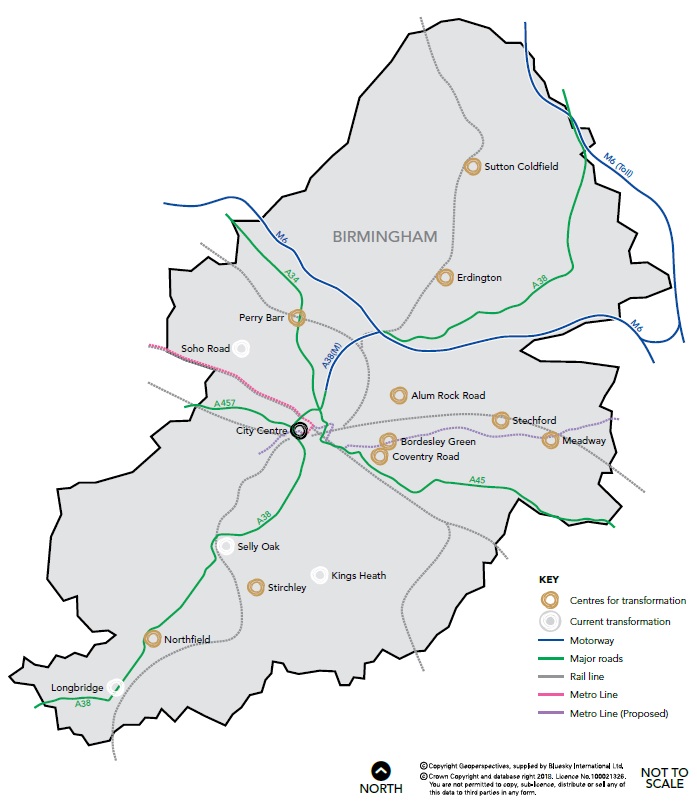Birmingham Urban Centres Framework
Feedback updated 1 Aug 2019
We asked
The network of over 70 Urban Centres and more than 100 parades, acts as a vital hub for activity in Birmingham, providing places for people to shop, socialise, live and work. They range in size, from Sutton Coldfield as the second largest after the City Centre, to smaller clusters in places like Kings Norton, Balsall Heath and Cotteridge. The full list of Urban Centres is contained within the Birmingham Development Plan and the Shopping and Local Centres Supplementary Planning Document.
You said
128 responses were received
We did
Please contact planningandregenerationenquiries@birmingham.gov.uk with any questions
Overview
Please note the consultation on the draft Birmingham Urban Centres Framework has been extended until the 18th March
The network of over 70 Urban Centres and more than 100 parades, acts as a vital hub for activity in Birmingham, providing places for people to shop, socialise, live and work. They range in size, from Sutton Coldfield as the second largest after the City Centre, to smaller clusters in places like Kings Norton, Balsall Heath and Cotteridge. The full list of Urban Centres is contained within the Birmingham Development Plan and the Shopping and Local Centres Supplementary Planning Document.
With over 51,100 homes, significant new jobs and major infrastructure planned over the next 15 years, Urban Centres and parades will have a central role in delivering the city’s agenda for inclusive economic growth. The network needs to evolve further to ensure it remains relevant and resilient for the future.
A draft Framework has been prepared to set the future direction of Urban Centres in Birmingham, which includes:
- Core Themes of Activity, Connectivity, and Design and Local Identity as the components of successful Urban Centres.
- A Spatial Strategy, with Centres of Transformation identified as major opportunities for investment and development.
- An approach to Delivery which sets out how change can be delivered in Urban Centres based around enabling activities, funding and partnerships. This is supported by a Toolkit which provides practical advice and information on how Centres can be made more active, attractive and connected.

An initial list of priority Centres of Transformation has been identified, including major changes to Perry Barr with the investment in the Commonwealth Games Athletes Village. The other centres of transformation in the draft Framework are Sutton Coldfield, Bordesley Green, Coventry Road, Stechford, Meadway, Erdington, Northfield, Stirchley and Alum Rock Road.
The draft Framework and Toolkit is available to view below, and we welcome your views on the documents via the online survey.
Why your views matter
An online survey has been set up for people and organisations to provide their comments on the draft Framework (a copy is available to download below). People can also provide comments by email or post (Planning & Development, Birmingham City Council, 1 Lancaster Circus, Birmingham, B4 7DJ).
The draft Framework can also be viewed at libraries throughout the City, and at 1 Lancaster Circus, Birmingham, B4 7DJ.
Meetings will also be held with key stakeholders throughout the consultation period. Please get in touch with us if you would like to organise a meeting.
What happens next
What Happens Next
The preparation of the Framework is progressing to the following timetable:
- Public consultation on the Draft Framework – 26th November 2018 to 18th February 2019
- Review comments and prepare final Framework – Spring 2019
- Adoption of final Framework by Cabinet – Summer 2019
Areas
- All Areas
Audiences
- Anyone from any background
Interests
- Arts & Culture
- Libraries
- Parks & Green Spaces
- Environment
- Planning
- Regeneration
- Transport (Including Walking)
- Business
- Communications/Technology
- Employment
- parks

Share
Share on Twitter Share on Facebook